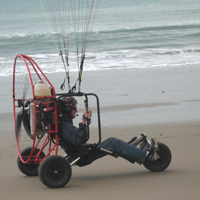Learn to Fly a PPG Trike!

|
For those pilots wanting a less strenuous way to enjoy the friendly skies, our network of Certified Instructor/Dealers offer a complete syllabus and practical training course focused on the PPG Trike!
Our certified instructors will take you from the simulator to the skies using our "Natural Progression" learning technique, where you master each skill before moving on to the next.
The First Day
Your instructor will usually meet early in the morning at a level field where there are no obstructions. You will run the motor up and practice the Inflation/Taxi/Launch sequence in the trike with it sitting against the trailer or truck so it cannot move. When the throttle control is learned and demonstrated, the student will then "fly" the trike around the field carefully using the ITL sequence techniques and get a feel for the trike.
Youand your instructor will then determine if there is any wind, and lay the canopy out on the ground facing the direction the wind is coming. Once you attach the trike to the risers and put your helmet on, you will seat yourself in the trike and do a preflight check.
Usually, your instructor will demonstrate the inflation,  so you can see how the wing is brought overhead for inspection before launching. Rolling along the ground with the wing overhead is called "taxiing". You will see how we control the wing's direction with the brake toggles. Staying balanced underneath the wing is the pilot's job, steering the trike with their feet. When it is time to bring the wing down, you will pull the brake handles down to your seat, making the wing stop and return to the ground.
so you can see how the wing is brought overhead for inspection before launching. Rolling along the ground with the wing overhead is called "taxiing". You will see how we control the wing's direction with the brake toggles. Staying balanced underneath the wing is the pilot's job, steering the trike with their feet. When it is time to bring the wing down, you will pull the brake handles down to your seat, making the wing stop and return to the ground.
Your instructor has been evaluating the weather all morning, and will determine whether it is appropriate for you to fly. After a breifing of the launch, review of your flight plan and discussion of the approach and landing, it's time to set up for your flight. When you can consistently bring the glider overhead, "contact" the wing using the brakes, and control the direction of travel while taxiing forward into the wind, you will be rewarded by being lifted gently off the ground as the wing gains airspeed.
This is where it is very important that you do not overcontrol the wing. Gentle input using the brakes to effect your direction of travel will be the safest approach for now. Deep, aggressive input will stop or imbalance the wing, and you will not fly. Failure to settle and balance the wing overhead before launching will result in either an "Accidental Launch" or Emergency Takeoff" or worse, simply an accident or emergency.
You may want to have someone come along to take pictures of you. We've seen some pretty big smiles and bright eyes after a pilot's first solo flight! It will be an experience you will never forget!
By the end of the first lesson, most of our students get their first solo flight in a trike. The next lessons will focus on becoming a smooth, competent pilot - practicing inflations, extended taxiing, launching, flying, approach, landing without power, spot landings, throttle control, plus many ground based discussions including airspace restrictions, equipment care, motor maintenance, weather to fly evaluations and paraglider collapse response and recovery.
"When once you have tasted flight, you will forever walk the earth with your eyes turned skyward, for there you have been, and there you will always long to return."
- Leonardo da Vinci
Trike Evaluation: |
|
Pros: |
Cons: |
No Running |
Less Transportable |
No Carrying the Motor |
More Set-Up Time |
Easier Light Wind Launch |
More Room to Launch |
Safer Downwind Landings |
Additional Cost |
Easier at High Altitudes |
Difficult in High Wind |
Easier & Safer for Tandem |
More Skill Required |

